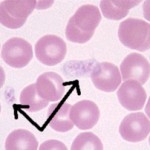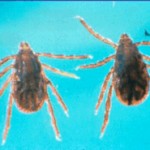Carpata, Ticks, Teken, Rhipicephalus sanguineus
What are ticks?
Ticks are parasitic arthropods that feed on the blood of their hosts. They are attracted to warmth and motion, often seeking out mammals – including dogs. Ticks tend to hide out in tall grass or plants in wooded areas waiting for prospective hosts. Once a host is found, the tick climbs on and attaches its mouthparts into the skin, beginning the blood meal. Once locked in place, the tick will not detach until its meal is complete. It may continue to feed for several hours to days, depending on the type of tick. On dogs, ticks often attach themselves in crevices and/or areas with little to no hair – typically in and around the ears, the areas where the insides of the legs meet the body, between the toes, and within skin folds. Most species of ticks go through four life stages – eggs, larvae, nymphs, and adults. All stage beyond eggs will attach to a host for a blood meal (and must do so on order to mature). Depending on species, the life span of a tick can be several months to years, and female adults can lay hundreds to thousands of eggs at a time. The following types of ticks are among the most common seen in North America:
- Deer tick
- Brown dog tick
- Lone star tick
- American dog tick
The Dangers of Ticks.
Though they are known vectors of disease, not all ticks transmit disease – in fact, many ticks do not even carry diseases. However, the threat of disease is always present where ticks are concerned, and these risks should always be taken seriously. Most tick-borne diseases will take several hours to transmit to a host, so the sooner a tick is located and removed, the lower the risk of disease. The symptoms of most tick-borne diseases include fever and lethargy, though some can also cause weakness, lameness, joint swelling and/or anemia. Signs may take days, weeks or months to appear. Some ticks can cause a temporary condition called “tick paralysis,” which is manifested by a gradual onset of difficulty walking that may develop into paralysis. These signs typically begin to resolve after tick is removed. If you notice these or any other signs of illness in your dog, contact your veterinarian as soon as possible so the proper testing and necessary treatments can begin. The following are some of the most common tick-borne diseases:
- Lyme disease
- Ehrlichiosis
- Rocky Mountain spotted fever
- Anaplasmosis
- Babesiosis
- Carpata, Ticks, Teken, Rhipicephalus sanguineus
Finding and Removing Ticks from Your Dog
To search for ticks on your dog, run your hands all over the body, paying close attention to the ears neck, skin folds and other crevices. You may prefer to wear latex gloves. Closely examine any raised areas closely by parting the hair, making sure you are in a very well-lit area (you can even use a flashlight). Depending on species and life stage, a tick may be as small as a pencil point or as large as a lima bean (when engorged). If you live in an area where ticks are prevalent, or your dog spends a lot of time in high grasses or wooded areas, you should check for ticks once or twice a day. If you find an embedded tick, be sure to remove it promptly. Here’s how:
1. Wear latex gloves to protect yourself. Use a pair of tweezers or a specially-designed tick removal tool to grasp the tick at the point of attachment. This should be done as close to the skin as possible.
2. Be very careful not to squeeze the body of the tick, as this may cause bacteria and disease containing materials to be injected into the site.
3. Pull the tick straight out from the skin slowly and steadily (without twisting or turning). Some of your dog’s skin may come off with the tick, but this is normal. If bleeding occurs, apply light pressure to the area.
4. Once removed, the tick should be handled carefully. While some people prefer to flush ticks down the toilet, saving the tick for further identification is a good idea. Place the tick in a small airtight container (like a pill vial or jar).
You may wish to add some rubbing alcohol to the container. Label the container with the date and store in case future illness occurs, as identification may become necessary.
5. If part of the tick’s head still appears to be embedded, use the tweezers to gently pull it out. If some of the head cannot be removed, do not become alarmed. This should fall off eventually and rarely causes complications.
6. After tick removal, clean your dog’s skin at the bite area with mild soap and water. Watch this spot for several days in case of further irritation or infection. If the area does not clear up in a few days, contact your veterinarian.
There are really no shortcuts that can make a tick release itself from its host – a tick will not voluntarily detach until its meal is complete. DO NOT apply hot matches, nail polish, petroleum jelly, alcohol or other chemicals to the site. These methods are not affective and can actually be harmful to your dog.
Tick Prevention for Dogs
The best way to protect your dog from the hazards of ticks is to keep them from attaching to your dog in the first place. As stated earlier, routine checks should be done to search for ticks on your dog. Finding them before they attach is helpful, but this is not the most accurate method of prevention. To reduce the number of ticks hiding out in your yard, keep grass mowed and plants neatly trimmed. You may also choose to treat outdoor areas with pesticides, but be sure to use a substance that is safe for dogs and sure to use a substance that is safe for dogs and preferably environmentally-friendly.
One of the most effective ways to keep ticks off your dog is to directly apply a tick prevention product specifically designed for dogs. Topical products like Frontline, Revolution, Advantix, and bioSpot are designed to be applied monthly to prevent ticks. Another option is a tick collar, such as the Preventic collar. Some products are available over-the-counter while others require a prescription. Though approved for use on dogs, be aware that these products contain toxic components and should ALWAYS be used according to the directions.
Do not use extra amounts of a product or apply more than one at the same time. Take note that most of these products are highly toxic to cats. Talk to your veterinarian about the best options for your dog’s lifestyle. Also be aware that not all products will work for every dog, so a bit of trial and error may be in order. With the proper knowledge, you can help defeat the dreaded tick and protect your dog, your family and yourself from the dangers of tick-borne diseases. Carpata, Ticks, Teken, Rhipicephalus sanguineus Females
- Erlichea canis in blood platelets
- Male
- Female




